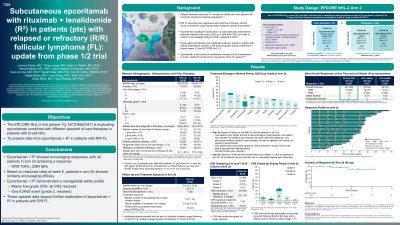Back

Industry Encore Posters
JL1033E: Subcutaneous epcoritamab with rituximab + lenalidomide (R2) in patients (pts) with relapsed or refractory (R/R) follicular lymphoma (FL): update from phase 1/2 trial
Saturday, October 22, 2022
10:00 AM – 11:00 AM ET


Landon Shupe, PharmD
Medical Science Liaison
Genmab US, Inc.
Poster Presenter(s)
Background:
R/R FL is associated with poor prognosis and less frequent, shorter responses with each line of treatment (Tx). Although R2 is an effective regimen in R/R FL with an acceptable safety profile, FL remains incurable; thus, better Tx options are needed. Subcutaneous epcoritamab is a bispecific antibody that simultaneously binds to CD3 on T cells and CD20 on malignant B cells. In the dose-escalation part of the phase 1/2 EPCORE NHL-1 trial, single-agent epcoritamab (0.76–48 mg) resulted in an overall response rate of 90% and a complete response rate of 50% in R/R FL. The distinct mechanisms of action of epcoritamab and R2 may combine to increase antitumor response, with generally non-overlapping toxicity profiles. We present updated data for epcoritamab with R2 in R/R FL (EPCORE NHL-2 arm 2; NCT04663347).
Methods:
Adults with R/R CD20+ FL received epcoritamab + R2 for 12 cycles (C) of 28 d; epcoritamab was administered at 24 or 48 mg in dose escalation and 48 mg in expansion. During C1, step-up epcoritamab dosing and corticosteroids were required to mitigate CRS. Response was assessed by PET-CT. The epcoritamab regimen for these pts was: Q1W, C1–3; Q2W, C4–9; Q4W, C≥10 up to 2 y.
Results:
As of December 1, 2021, 30 pts (median age, 68 y) had received epcoritamab + R2 (24 mg, n=3; 48 mg, n=27), 21 pts (70%) had stage IV disease, and 20 pts (67%) had FLIPI scores 3–5. Median (range) number of prior lines of therapy was 1 (1–5), 30% had primary refractory disease, and 40% had disease progression within 24 mo after starting first-line Tx (20% within 24 mo after starting immunochemotherapy). At a median (range) follow-up of 5.1 mo (0.8–12.3), 25 pts (83%) remained on Tx; 5 pts discontinued Tx due to progression (n=2), AEs (n=2), or consent withdrawal (n=1). Common Tx-emergent AEs (TEAEs) of any grade (G) included infections (57%), injection-site reactions (50%), constipation (37%), fatigue (37%), and neutropenia (37%). CRS was seen in 15 pts (50%; G1/2 43%, G3 7%), with most events in C1. All CRS events resolved with standard management, including tocilizumab in 3 pts, and 1 pt discontinued Tx due to CRS. One pt experienced G2 ICANS. No fatal TEAEs occurred. Antitumor activity is shown in the Table. As of the data cut, all responders remained in response, with the longest duration of response being 7.0+ mo and ongoing.
Conclusions:
Subcutaneous epcoritamab+ R2 exhibits promising efficacy, including a high CMR rate, in pts with R/R FL. The safety profile was consistent with prior data, and CRS events were generally low grade and in C1. Updated data with an additional 30 pts will be presented.
Table. Antitumor Activity
Table
To view the table, please click on this link from the e-poster gallery on jadprolive.com
R/R FL is associated with poor prognosis and less frequent, shorter responses with each line of treatment (Tx). Although R2 is an effective regimen in R/R FL with an acceptable safety profile, FL remains incurable; thus, better Tx options are needed. Subcutaneous epcoritamab is a bispecific antibody that simultaneously binds to CD3 on T cells and CD20 on malignant B cells. In the dose-escalation part of the phase 1/2 EPCORE NHL-1 trial, single-agent epcoritamab (0.76–48 mg) resulted in an overall response rate of 90% and a complete response rate of 50% in R/R FL. The distinct mechanisms of action of epcoritamab and R2 may combine to increase antitumor response, with generally non-overlapping toxicity profiles. We present updated data for epcoritamab with R2 in R/R FL (EPCORE NHL-2 arm 2; NCT04663347).
Methods:
Adults with R/R CD20+ FL received epcoritamab + R2 for 12 cycles (C) of 28 d; epcoritamab was administered at 24 or 48 mg in dose escalation and 48 mg in expansion. During C1, step-up epcoritamab dosing and corticosteroids were required to mitigate CRS. Response was assessed by PET-CT. The epcoritamab regimen for these pts was: Q1W, C1–3; Q2W, C4–9; Q4W, C≥10 up to 2 y.
Results:
As of December 1, 2021, 30 pts (median age, 68 y) had received epcoritamab + R2 (24 mg, n=3; 48 mg, n=27), 21 pts (70%) had stage IV disease, and 20 pts (67%) had FLIPI scores 3–5. Median (range) number of prior lines of therapy was 1 (1–5), 30% had primary refractory disease, and 40% had disease progression within 24 mo after starting first-line Tx (20% within 24 mo after starting immunochemotherapy). At a median (range) follow-up of 5.1 mo (0.8–12.3), 25 pts (83%) remained on Tx; 5 pts discontinued Tx due to progression (n=2), AEs (n=2), or consent withdrawal (n=1). Common Tx-emergent AEs (TEAEs) of any grade (G) included infections (57%), injection-site reactions (50%), constipation (37%), fatigue (37%), and neutropenia (37%). CRS was seen in 15 pts (50%; G1/2 43%, G3 7%), with most events in C1. All CRS events resolved with standard management, including tocilizumab in 3 pts, and 1 pt discontinued Tx due to CRS. One pt experienced G2 ICANS. No fatal TEAEs occurred. Antitumor activity is shown in the Table. As of the data cut, all responders remained in response, with the longest duration of response being 7.0+ mo and ongoing.
Conclusions:
Subcutaneous epcoritamab+ R2 exhibits promising efficacy, including a high CMR rate, in pts with R/R FL. The safety profile was consistent with prior data, and CRS events were generally low grade and in C1. Updated data with an additional 30 pts will be presented.
Table. Antitumor Activity
Table
To view the table, please click on this link from the e-poster gallery on jadprolive.com

